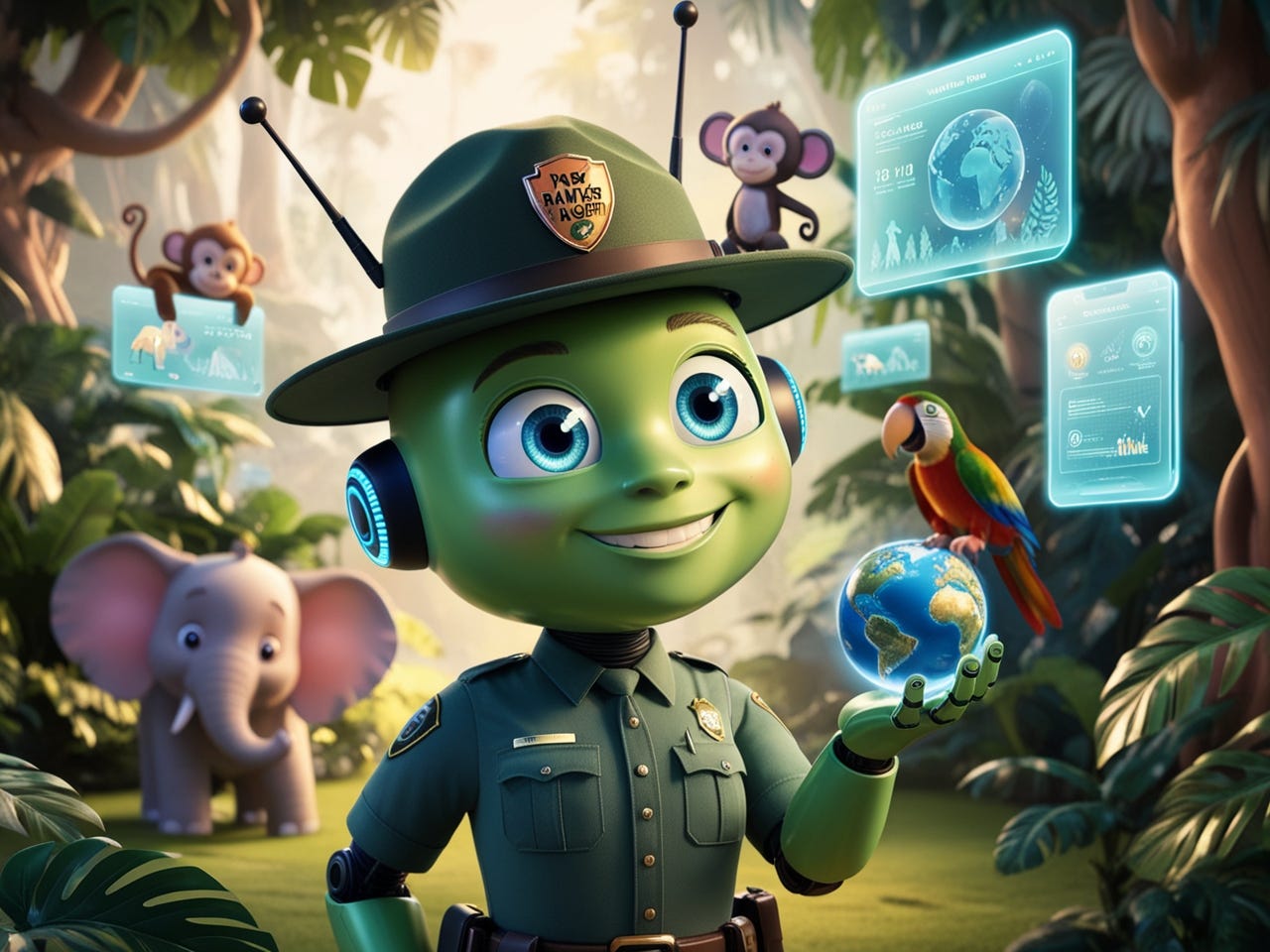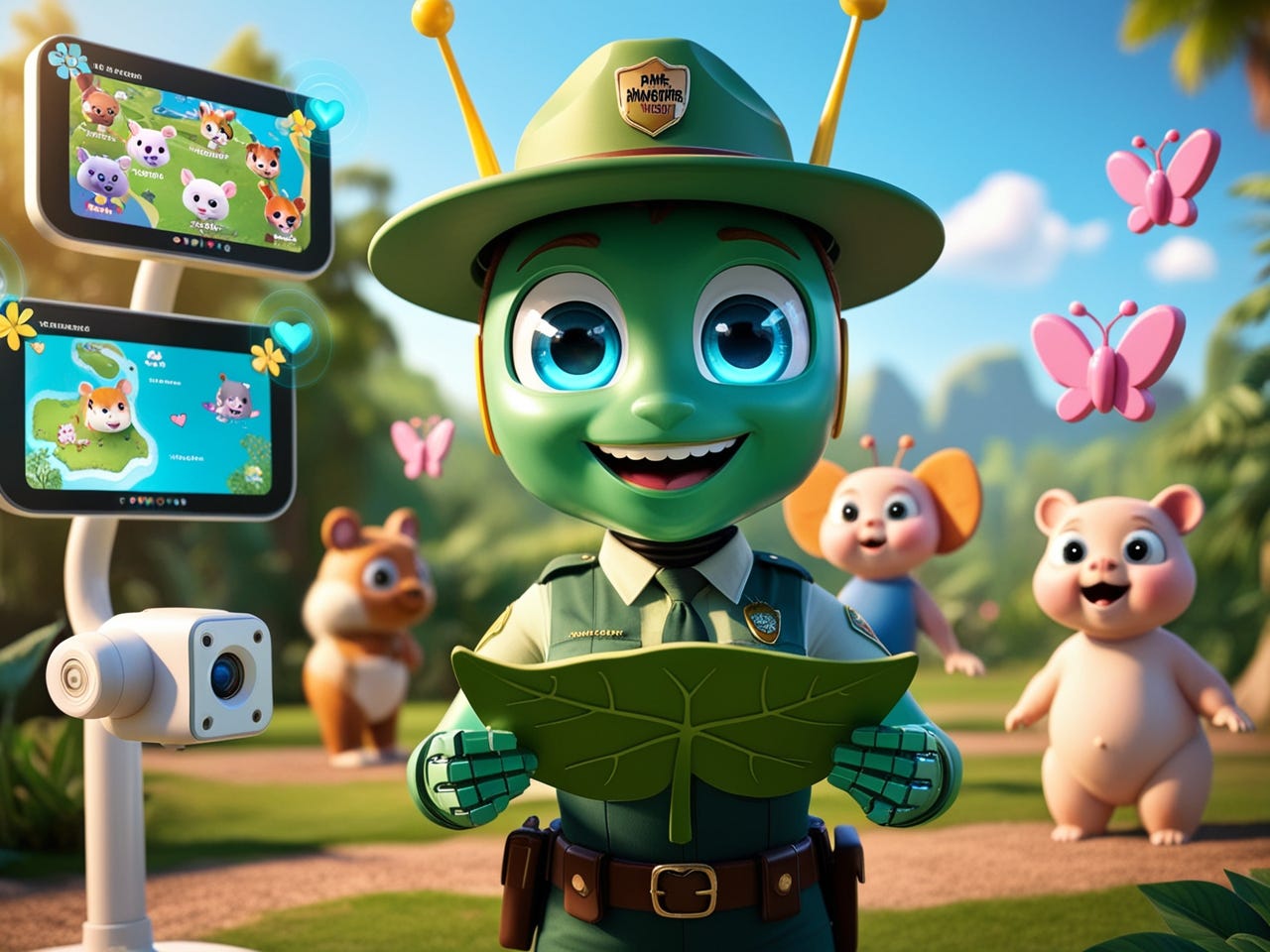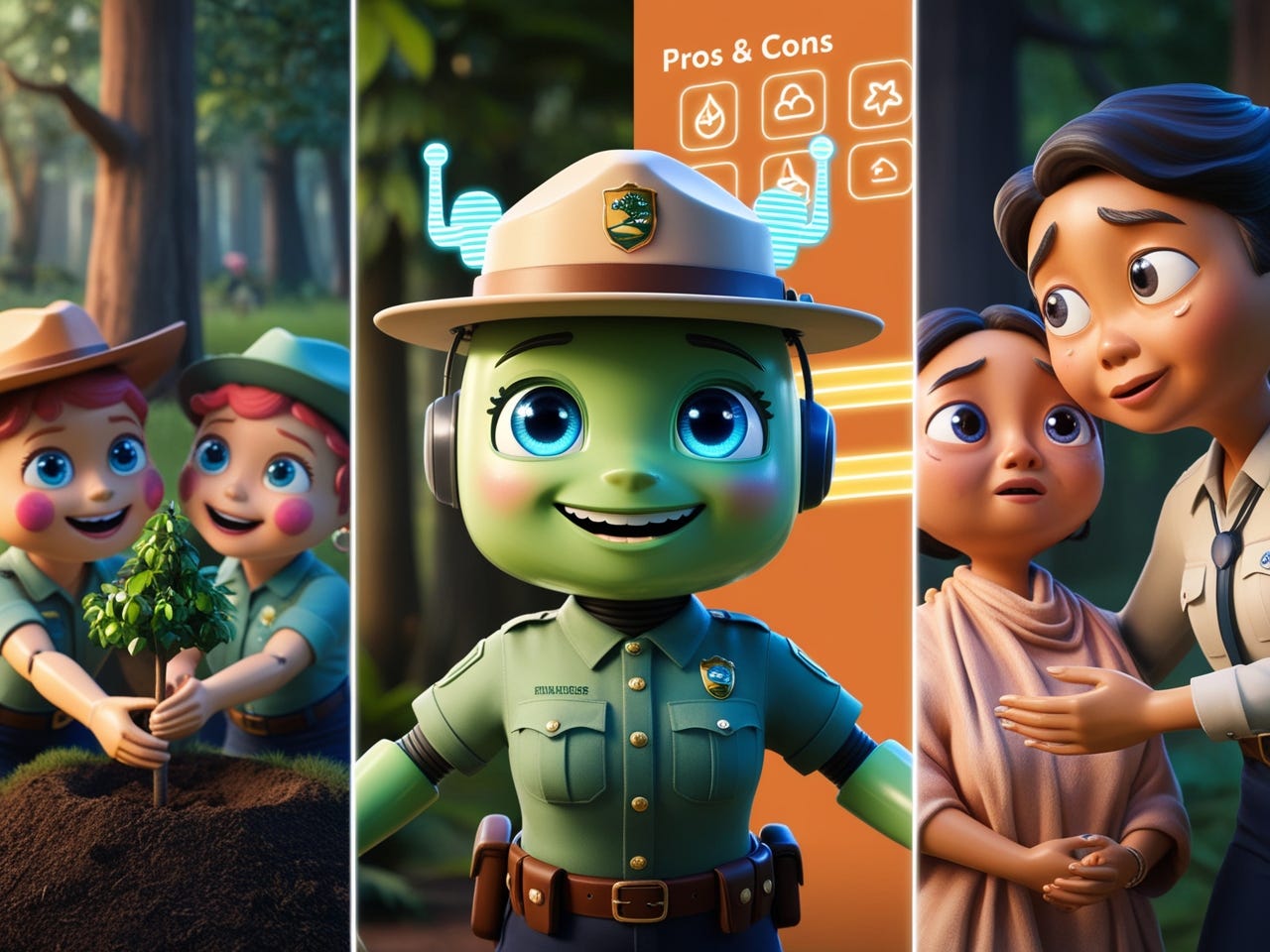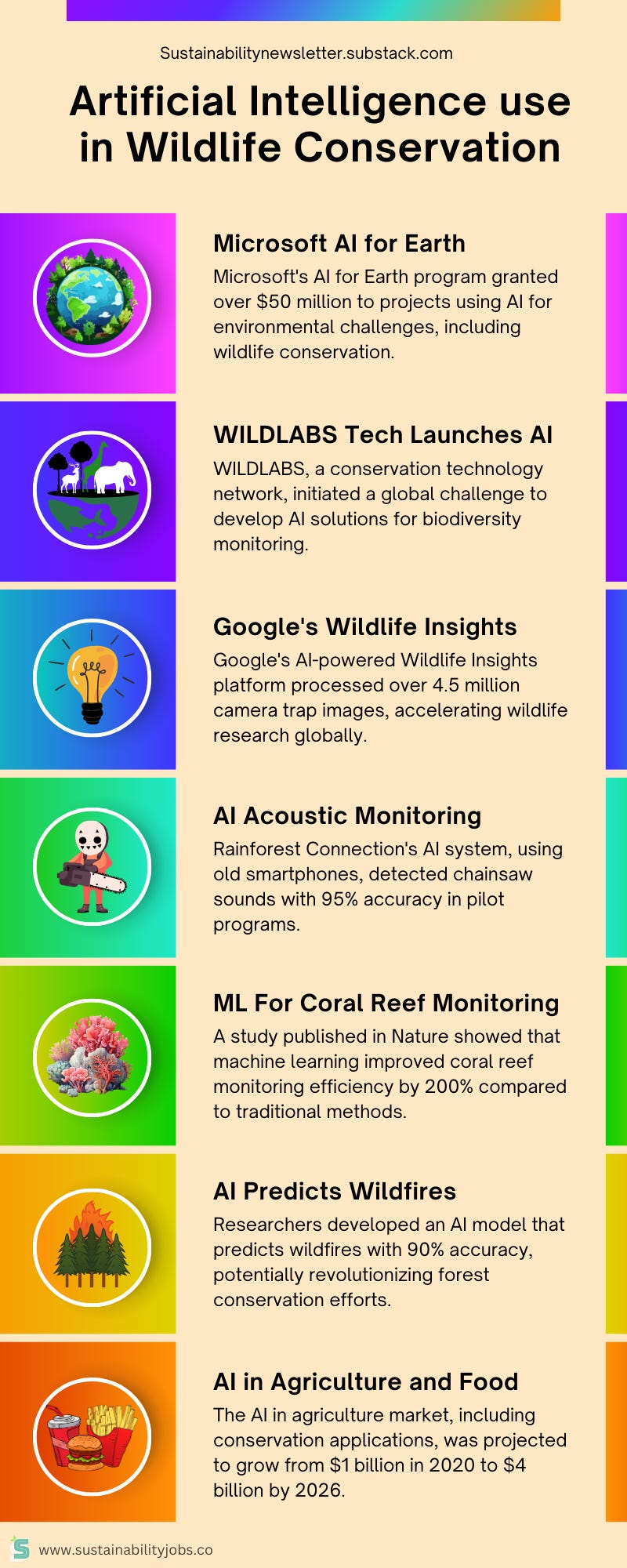How AI is transforming #Wildlife🦁Conservation
This post includes a detailed expert overview, Audio Podcast, the top two news stories, a data infographic, two tables on AI in Conservation with Pros & Cons, Sustainability Jobs, and more... 💚
Will dear Robots Protect Rhinos?? 🤔
I NEVER imagined I'd see the day when artificial intelligence would be our ally in protecting the natural world. Yet here we are, in an era where robots join park rangers on patrols and algorithms predict poacher movements….. It's a brave new world for conservation, and I find myself both excited and apprehensive about what it means for our relationship with nature.
LEt’s talk about this fascinating world where silicon meets savannas, and machine learning meets migration patterns. It's a story of hope, innovation, and yes, some serious concerns too……YEAH, Villians are everywhere… 👹
The AI Revolution in Conservation
When I first heard about AI being used in conservation, I was skeptical…..
How could cold, calculating machines help protect the warm, breathing creatures we're trying to save???
But as I dug deeper, I realized that AI's strengths — processing vast amounts of data, recognizing patterns, and making rapid decisions - are exactly what we need to tackle some of conservation's biggest challenges.
Take the story of Mara (I heard in a documentary), a northern white rhino in Kenya's Ol Pejeta Conservancy. Mara's species is on the brink of extinction, with only two females left in the world. Thanks to AI 🤖, she has a fighting chance. A network of cameras and sensors, powered by machine learning algorithms, tracks Mara's movements 24/7. If a poacher approaches, the system alerts rangers immediately.
This isn't science fiction — it's happening right now. And it's not just rhinos benefiting from this tech. From elephants in Tanzania to tigers in India, AI is becoming a crucial tool in wildlife protection.
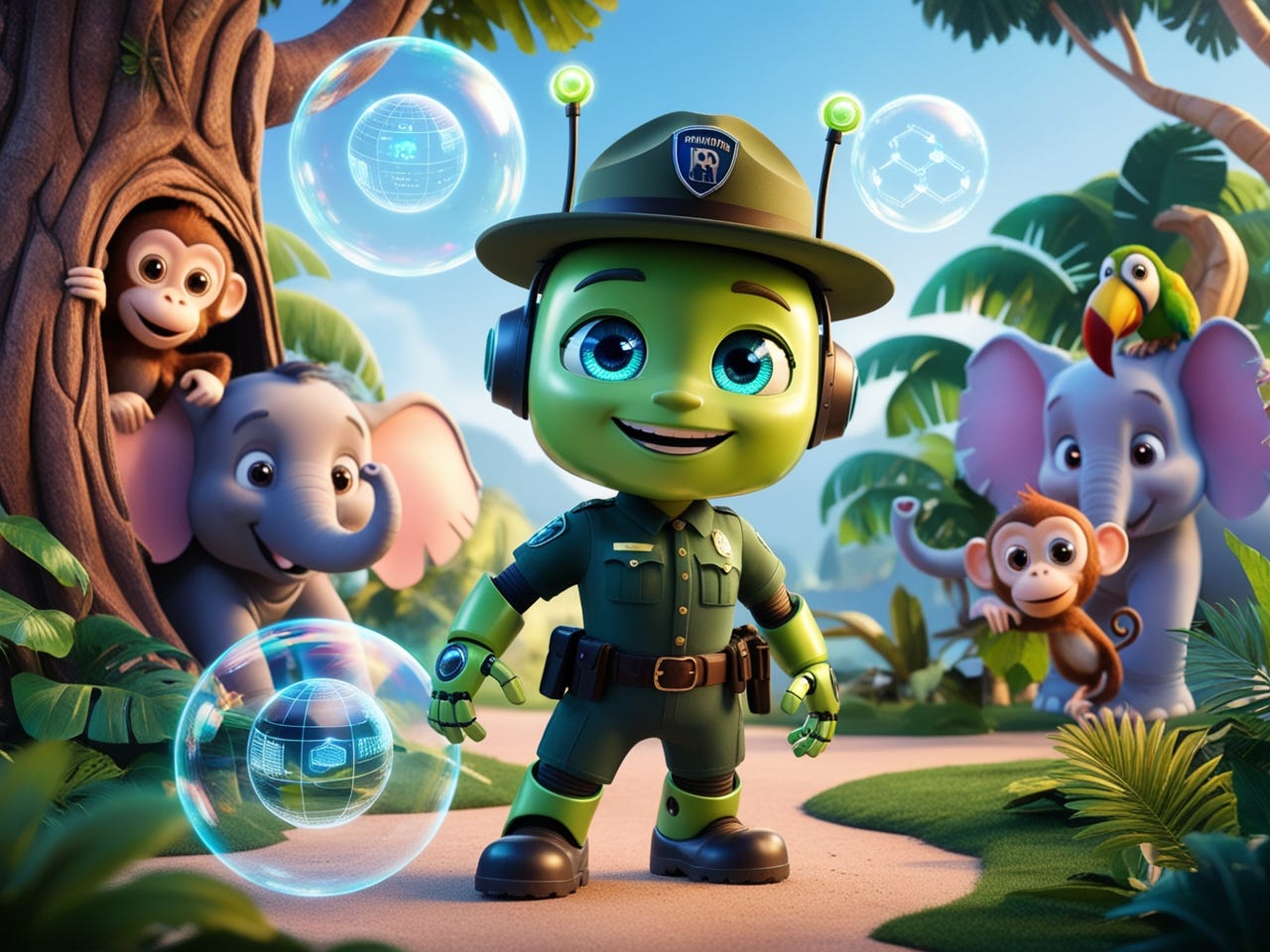
Eye-Catching Projects Around the World
1. Rainforest Connection (RFCx) - Eavesdropping on Ecosystems
In the heart of the Amazon, old cell phones are getting a second life as guardians of the forest. The Rainforest Connection project uses recycled smartphones equipped with solar panels to create a real-time monitoring system for illegal logging.
These devices, hidden high in the canopy, continuously record the sounds of the forest. AI algorithms analyze these sounds in real-time, distinguishing between natural noises and the telltale buzz of chainsaws or the rumble of logging trucks. When illegal activity is detected, alerts are sent to local authorities who can intervene quickly.
Maria, a member of an Indigenous community partnering with RFCx, said,
"Before, we felt helpless against loggers. Now, it's like the forest itself is speaking to us, warning us of danger. It's given us hope."
But it's not all positive. Some conservationists worry that relying on technology might reduce the presence of human rangers, potentially weakening the connection between local communities and their forests.
2. PAWS (Protection Assistant for Wildlife Security) - Outsmarting Poachers
In Uganda's Queen Elizabeth National Park, rangers are getting an AI boost in their fight against poaching. The PAWS system uses machine learning to predict where poachers are most likely to strike.
By analyzing data on past poaching incidents, animal movements, and even lunar cycles, PAWS generates patrol routes that maximize the chances of intercepting poachers. It's like having a super-smart strategist planning every move.
Ranger Joseph Okello admitted,
"At first, I was doubtful. But after using PAWS, our team's effectiveness has doubled. We're catching poachers we would have missed before."
However, there are concerns. Some worry that if poachers gain access to this technology, they could use it to avoid detection…... There's also the risk of over-reliance on AI, potentially dulling rangers' instincts and traditional tracking skills.
3. Wild Me - Putting a Name to a Face (or a Fin, or a Spot)
Imagine trying to keep track of thousands of individual animals across vast wilderness areas. That's the challenge Wild Me is tackling with AI-powered animal recognition software….this is interesting…. 😻
Their Wildbook platform can identify individual animals from photos, using unique markings like a zebra's stripes or a whale's fin shape. This allows researchers to track animal movements and population changes with unprecedented accuracy.
Marine biologist Dr. Sarah Chen shared,
"Before Wildbook, tracking whale sharks was like finding a needle in a haystack. Now, it's like each shark has its own Facebook profile. We can see where they've been, who they've been hanging out with. It's revolutionary for understanding their behavior and protecting their habitats."
BUT ,, this technology raises privacy concerns. Some researchers worry about the ethical implications of tracking individual animals so closely, and whether this data could be misused if it falls into the wrong hands.
4. Terra-i - Watching Forests from Space
Terra-i uses satellite imagery and machine learning to detect deforestation in near real-time. The system can spot changes in forest cover as small as a quarter of a hectare, sending alerts to local authorities and conservation organizations.
"Terra-i has transformed how we respond to deforestation," explains Carlos Gomez, a forest manager in Peru. "Instead of always being one step behind, we can now intervene before major damage is done."
AGAIN,,, the system isn't perfect. False positives can occur, leading to wasted resources. There's also concern that focusing on satellite data might lead to neglect of on-the-ground conservation efforts and traditional knowledge.
The Human Side of AI Conservation
These projects are impressive, but the real power of AI in conservation lies in how it amplifies human efforts. It's not about replacing rangers, researchers, or local communities - it's about giving them new tools…. simple as that..??
Amahle, a community conservation officer in South Africa, uses an AI-powered app to identify animal tracks and scat she encounters on her patrols.
"Now, it's like I have a whole team of experts with me in the field. I'm learning so much, and I can share that knowledge with my community."
Dr. James Harper, a climate scientist, uses AI to process vast amounts of data from weather stations, satellites, and ocean buoys.
"Climate change is such a complex problem," he explained. "AI helps us see patterns we might miss and make more accurate predictions."
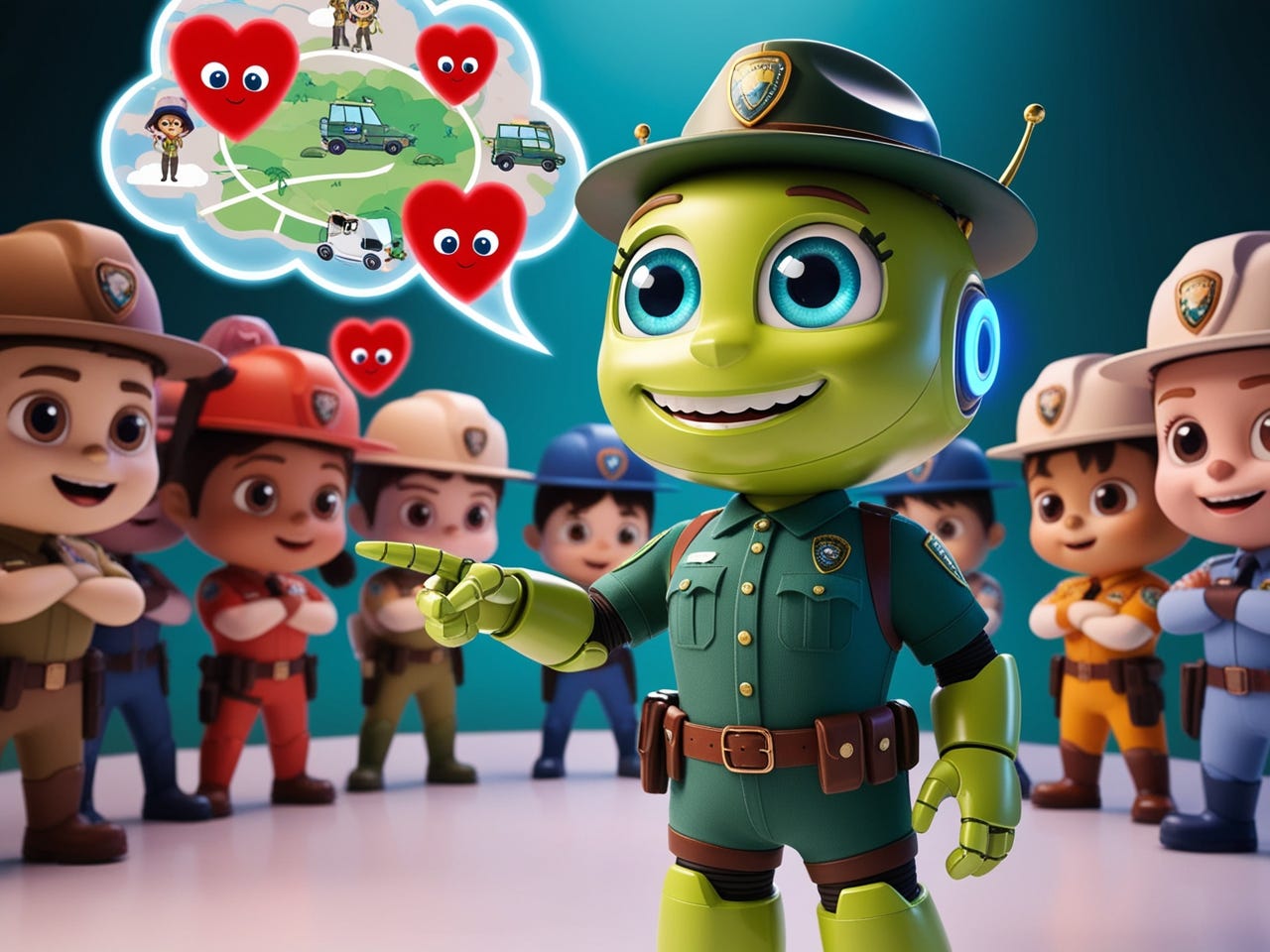
The Controversial Side of AI in Conservation
As excited as I am about these developments, We of course, can't ignore the controversies and challenges.
Let's tackle some tough questions:—
1. Does relying on AI for conservation reduce our connection to nature?
This is a concern I've heard from many conservationists. There's a fear that as we increasingly rely on technology, we'll become disconnected from the very environments we're trying to protect.
I think….
"When we outsource our understanding of nature to machines, we risk losing the empathy and wonder that drive conservation in the first place."
It's a valid point. I've felt the magic of tracking an animal through the forest, using all my senses and knowledge. Can an AI-powered camera ever replicate that connection?
On the flip side, AI enthusiasts argue that technology can actually deepen our connection to nature. "AI allows us to see and understand aspects of the natural world that were invisible to us before," says tech entrepreneur Maya Patel.
Well.. i think…. We need to find a balance. AI should enhance our connection to nature, not replace it. We must ensure that as we develop these technologies, we're also fostering direct experiences with the natural world.
2. Could AI-driven conservation efforts be hacked or manipulated?
Cybersecurity issues are growing day by day..
This is a scary thought. Imagine if poachers could hack into AI systems to avoid detection, or if unscrupulous companies could manipulate deforestation data.
Cybersecurity expert Jamal Kouri doesn't mince words:
"Any system can be hacked. The more we rely on AI for conservation, the more attractive a target it becomes for those with malicious intent."
It's not just about external threats either. There's also the risk of bias in the AI systems themselves. If the data used to train these algorithms is flawed or incomplete, it could lead to misguided conservation efforts.
The solution, according to AI ethicist Dr. Lina Chen, lies in transparency and robust safeguards.
"We need open-source AI models that can be scrutinized by the scientific community," she argues. "And we need strong cybersecurity measures, regular audits, and failsafes that allow human override when necessary."
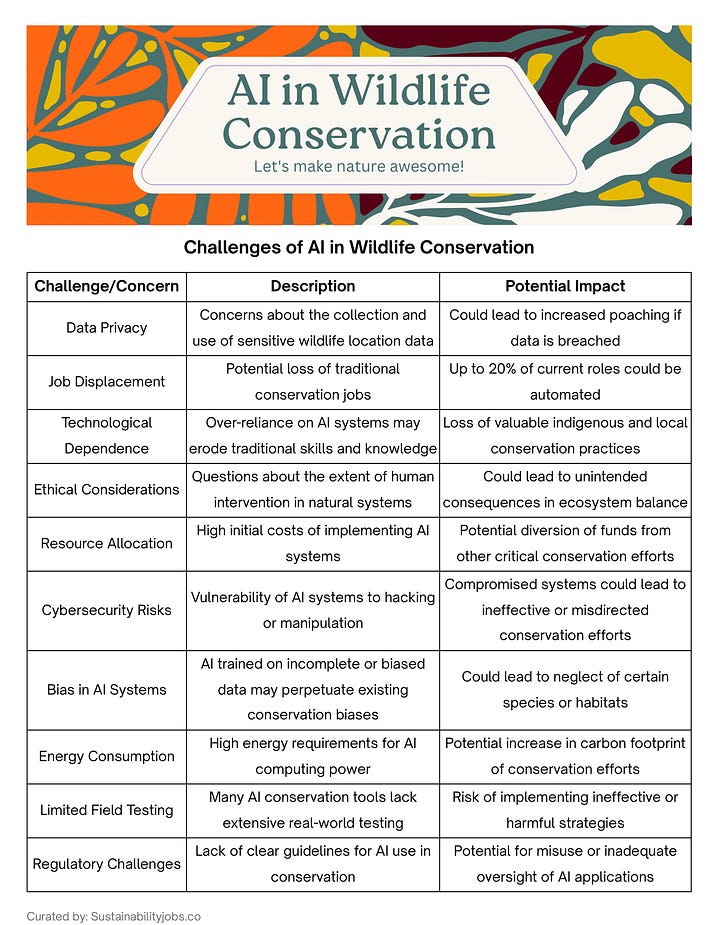
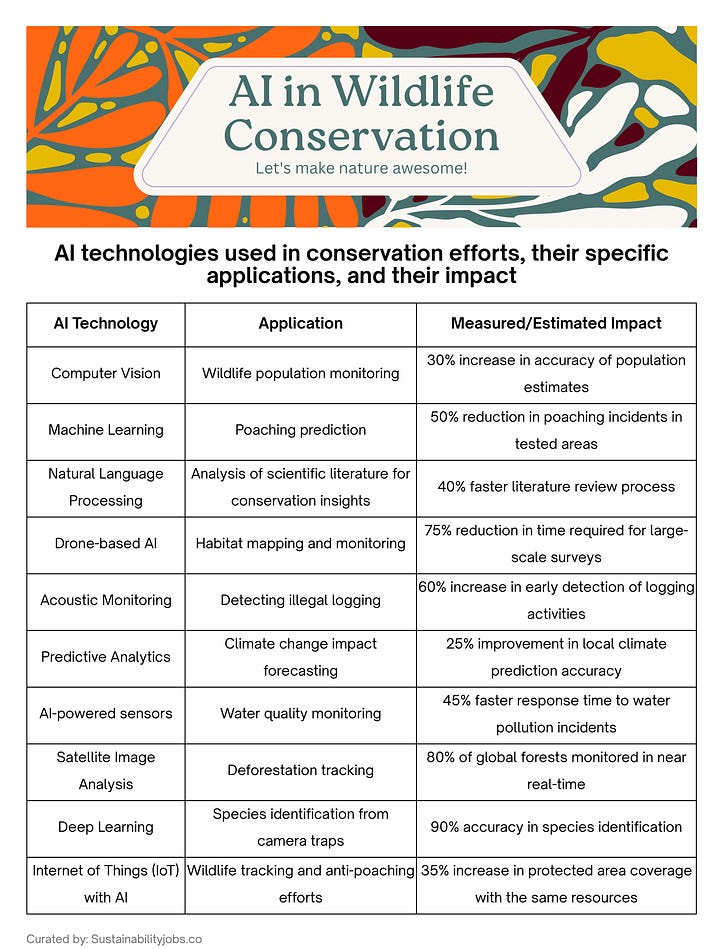
3. Is it ethical to use AI to manipulate ecosystems, even for conservation?
As AI gets more sophisticated, we are gaining the ability to intervene in ecosystems in ways we never could before. But should we?
Some projects are already pushing these boundaries. In Australia, AI-controlled underwater speakers are being used to attract fish to degraded coral reefs by playing the sounds of healthy reefs.
"We're playing God," warns environmental philosopher Dr. Alan Decker. "Even with the best intentions, we risk causing unforeseen damage to delicate ecological balances."
Others, like marine biologist Dr. Leilani Fukuda, see it differently.
"Ecosystems are already being massively disrupted by human activity," she points out. "If we can use AI to restore some balance, don't we have an obligation to do so?"
I don't have a clear answer. But I believe we need robust ethical frameworks and extensive research before deploying AI in ways that directly manipulate ecosystems.
4. Are we risking job losses in the conservation sector by introducing AI?
This is a concern I've heard from rangers, field researchers, and others working on the front lines of conservation. Will AI make their roles obsolete?
"I have devoted my life to protecting these forests," says Juan Mendoza, a ranger in Costa Rica. "The idea that a machine could do my job better than me... it's hard to swallow."
But proponents of AI in conservation argue that it will create new jobs and make existing ones more effective, not replace them.
"AI can handle the data crunching and pattern recognition, freeing up conservationists to focus on the tasks that require human judgment and local knowledge," explains Dr. Sarah Okoye, a conservation tech specialist.
From what I've seen, the reality is somewhere in the middle…… 📌 Some roles will likely become redundant, but new ones will emerge. The key will be ensuring that local communities and current conservation workers are trained and involved in the development and deployment of these new technologies.
The Benefits and Risks
As we go through this new frontier, it's crucial to weigh the benefits against the potential risks: Yeah Heros and Villans co exist…..
Benefits:
Enhanced monitoring capabilities
Improved prediction of threats to wildlife and habitats
More efficient use of limited conservation resources
Ability to process and analyze vast amounts of data quickly
Potential for new discoveries about animal behavior and ecosystem dynamics
Risks:
Over-reliance on technology at the expense of traditional knowledge and skills
Vulnerability to hacking or data manipulation
Potential job displacement in the conservation sector
Ethical concerns about privacy and ecosystem manipulation
Risk of perpetuating or exacerbating existing biases in conservation efforts
We must also consider the resource implications. While AI could lead to cost savings in the long run, the upfront investment required to implement these systems can be substantial, particularly in developing countries where many conservation efforts take place.
The Path Forward
I am filled with a mix of hope and caution…….. The potential for this technology to amplify our conservation efforts is enormous. But we must proceed thoughtfully.
We need to: 🙏
Invest in education and training to ensure that local communities and conservation workers can fully participate in and benefit from these technological advances.
Develop strong ethical guidelines and regulatory frameworks for the use of AI in conservation, with a focus on transparency and accountability.
Continue to foster direct connections with nature, using AI as a tool to enhance, not replace, our personal experiences with the natural world.
Encourage interdisciplinary collaboration between ecologists, AI specialists, ethicists, and local stakeholders to ensure a holistic approach to conservation challenges.
Remain vigilant about the potential misuse or unintended consequences of these technologies, always being ready to reassess and adjust our approach.
Invest in robust cybersecurity measures to protect AI systems from manipulation or misuse.
Conduct long-term studies on the ecological impacts of intensive AI-driven monitoring and interventions.
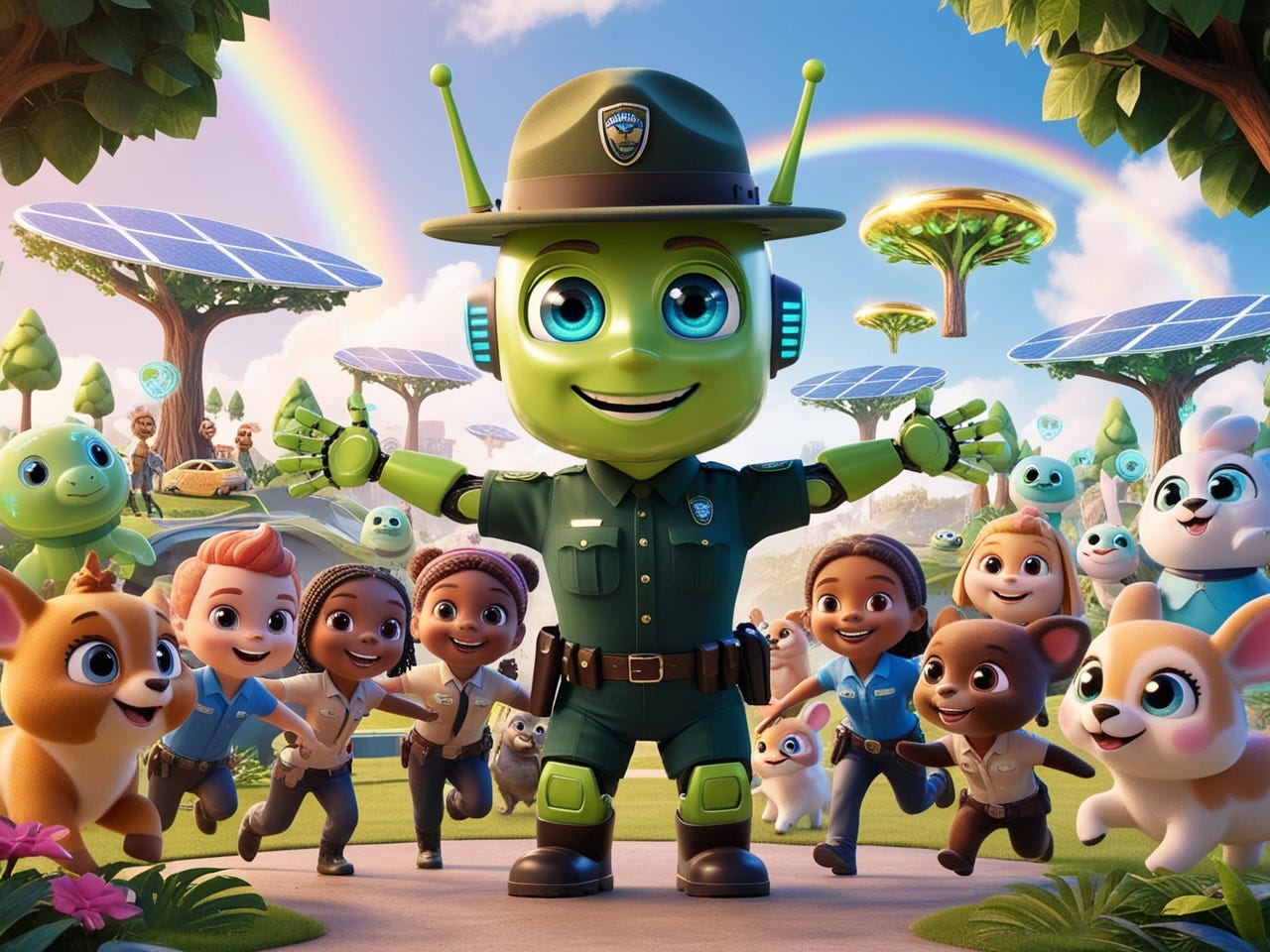
🔊AI and Wildlife #NEWS
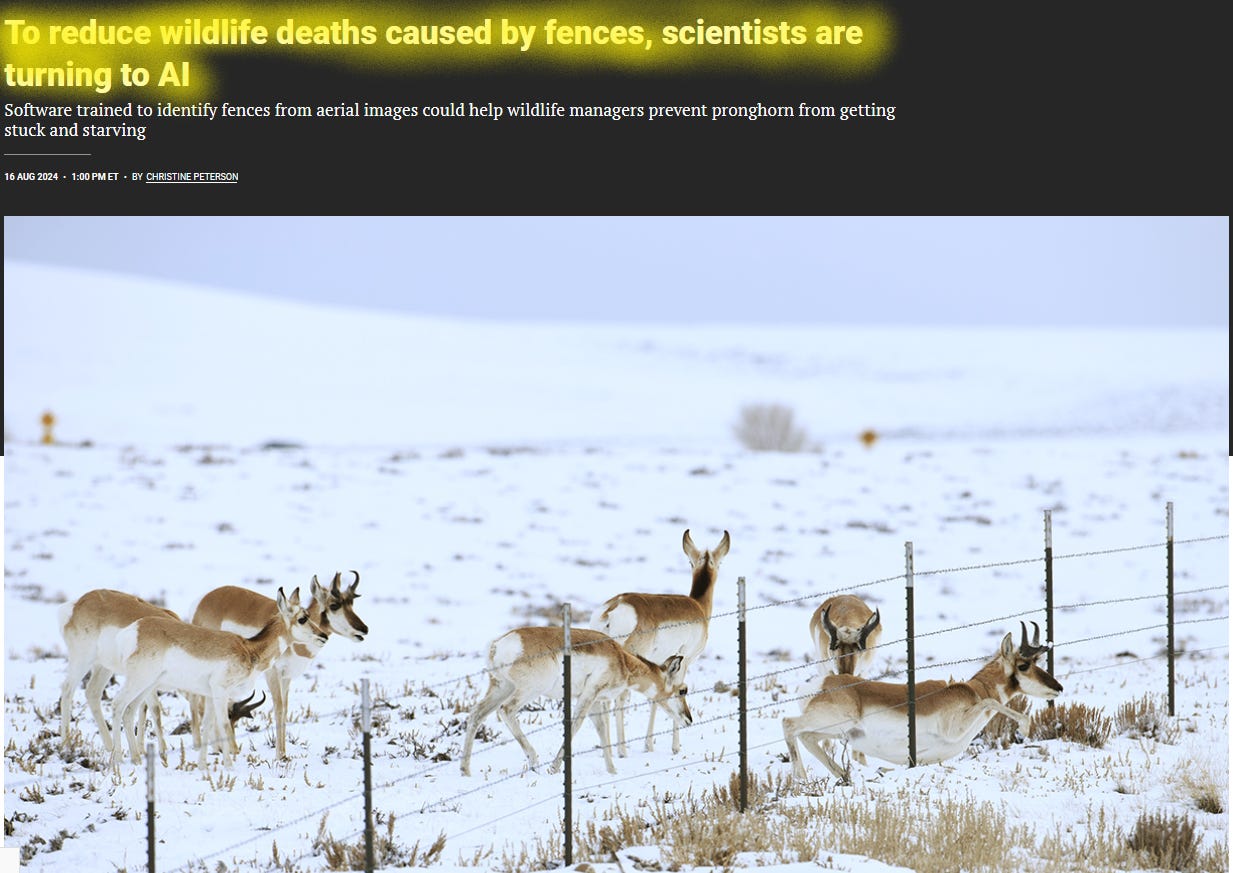
Researchers are using AI to address a wildlife conservation issue in the western U.S., where over a million kilometers of fences, originally built to contain livestock, obstruct migratory wildlife like deer and pronghorn. These fences prevent animals from finding food or escaping harsh weather.
Wenjing Xu and Zhongqi Miao trained AI to identify fences in aerial images of Wyoming, achieving 70% accuracy, with plans to expand to satellite imagery and improve the model.
Fences hinder wildlife migration, as shown in a recent study where pronghorns died trying to navigate through deep snow, blocked by fences. Conservationists are working to remove or modify fences, but the challenge lies in locating them. Xu and Miao’s AI approach aims to map fences systematically, helping wildlife managers make informed decisions. The method holds promise but needs refinement to distinguish fence types and improve accuracy. Expanding globally, this project could benefit other regions with similar challenges, though adapting AI to diverse environments remains challenging.
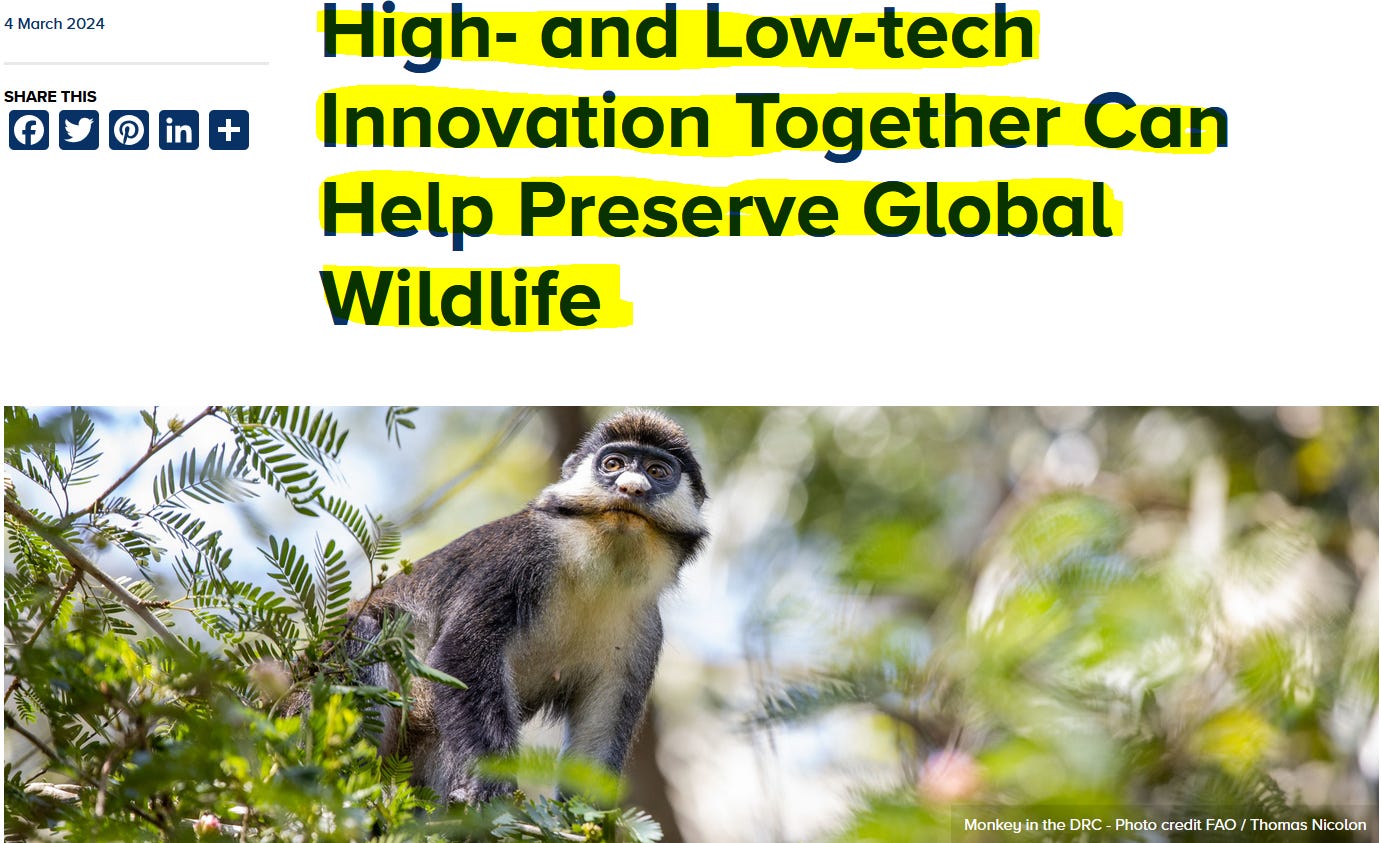
Nearly one billion people depend on wild food for their nutrition, with some remote areas sourcing up to 80% of their protein from wild meat. However, wildlife populations have declined by two-thirds over the past 50 years due to human activities like deforestation, overfishing, and unsustainable hunting. Despite these challenges, innovative solutions, including technology like drones and AI, are helping to protect biodiversity.
Alongside high-tech tools, low-tech innovations like role-playing games are crucial in promoting sustainable wildlife management. The Sustainable Wildlife Management (SWM) Programme, led by the FAO and partners, uses games to teach communities about sustainable practices. In the Congo Basin, a game using beans to represent animals helps hunters develop strategies to avoid overexploitation. Inspired by Dennis Meadows’ “Fishbanks” game, these activities allow participants to simulate real-world scenarios and explore long-term solutions without risk.
Games have also been implemented in other regions, like Guyana, Madagascar, and Zimbabwe, to foster environmental awareness and community cooperation. By simplifying complex issues, these games enable faster learning and collaboration, helping people develop sustainable strategies for wildlife management and food security.
.
.
As I write this, I'm looking out my window at a grove of trees. I can't help but wonder:
— — In 10 years, will an AI be able to tell me the health of each tree, the species of birds nesting in them, the carbon they're sequestering? Probably. But will it be able to capture the way the evening light filters through the leaves, or the sense of peace I feel looking at them? I doubt it.— —
And that, I think, is the key. AI is a powerful tool for conservation, but it's just that - a tool. The heart of conservation will always be our human connection to the natural world,,, our sense of wonder,,, and our desire to protect the beauty and diversity of life on Earth.
What do you think about the role of AI in conservation??? Have you had any experiences with these technologies in your local environment??? I'd love to hear your thoughts and stories. After all, the future of conservation isn't just up to the robots — — it's up to all of us. 😇
👋 Top 25 New Sustainability Jobs
Civil Engineer - Entry Level by Langan in Boston, USA
Graduate/Civil Engineer by Langan in London, UK
Geotechnical Engineer by Langan in London, UK
Environmental Intern 2025 by Langan in Boston, USA
Geotechnical Practice Leader by Langan Boston, USA
Senvion Technician by Siemens Gamesa in Canada
Lead Technicians by Siemens Gamesa in Canada
Urban Senior Planner by CSG Consultants in California, USA
Servicetechniker by IPSEN in Germany
Offshore Wind Bid Engineer by Iberdrola in France
Lead Sustainability Specialist by Iberdrola in Scotland, UK
Field Supervisor by Vestas in Ireland
Senior Mechanical Designer by Veolia in Sweden
Environmental Engineer or Geologist - Entry Level by Langan in Pennsylvania, USA
Field Service Technician by IPSEN in California, USA
Manager - Cost Estimation (Solar & Energy Storage) by ReNew in India
Electrical Engineer - Wind O&M by ReNew in India
EHS Quality - Team Member Civil by ReNew in India
Engineer-Solar O&M by ReNew in India
Fluvial Geomorphologist by AECOM in Canada, London
Development & Engagement Specialist – Environment by AECOM in Canada
Water Infrastructure Planner by AECOM in Australia
Jr. Electrical Project Engineer by Engie in Netherlands
Field Service Engineer by Engie in Netherlands
Project Developer Solar by Orsted in London, Scotland, Ireland
— — — — — 👇 🇺🇸 🇬🇧 🏴 🏴 🇮🇳 🇨🇦 🇦🇺 🇮🇪 👇 — — — — —
Sustainability Jobs NYC , Sustainability Jobs Los Angeles
Sustainability Jobs Chicago , Renewable Energy Jobs Texas
Renewable Energy Jobs California , Renewable Energy Jobs Colorado
— — — — —
📌Join Telegram Group for the latest Job Alerts
👋 Looking for More Jobs, DO NOT Click, 👉 Sustainability Jobs
✴️ Today’s Featured Employer is,
ENGIE is a global energy player, a pioneer of the Energy Transition. We are striving to make it affordable and reliable. Our commitment is to be Net Zero Carbon by 2045. Underpinning this commitment is an ambition: to become champion of zero carbon energies. To do so, we have a vision, one that is unique on the market: the alliance of the molecule and the electron.
ENGIE is strengthening its commitment and favoring a global approach by making nature conservation an integral part of its strategy:
By 2030, the Group has pledged to reduce the quantity of freshwater used for each megawatt hour produced by 70% compared to 2019.
🌈 "Want to enhance your organization's online presence and optimize your hiring process? Partner with us to get featured on our platform and experience a hiring solution that delivers real results. Let's connect!" 📧
🙏 ONE POST TOOK MORE THAN 70 HOURS OF RESEARCH & WORK. SO, FEEL FREE TO CLICK THE ❤️ BUTTON ON THE POST, SO MORE PEOPLE CAN DISCOVER THIS ON SUBSTACK 🥰. MORE FUN POSTS ARE ON THE WAY. CHEERS!






